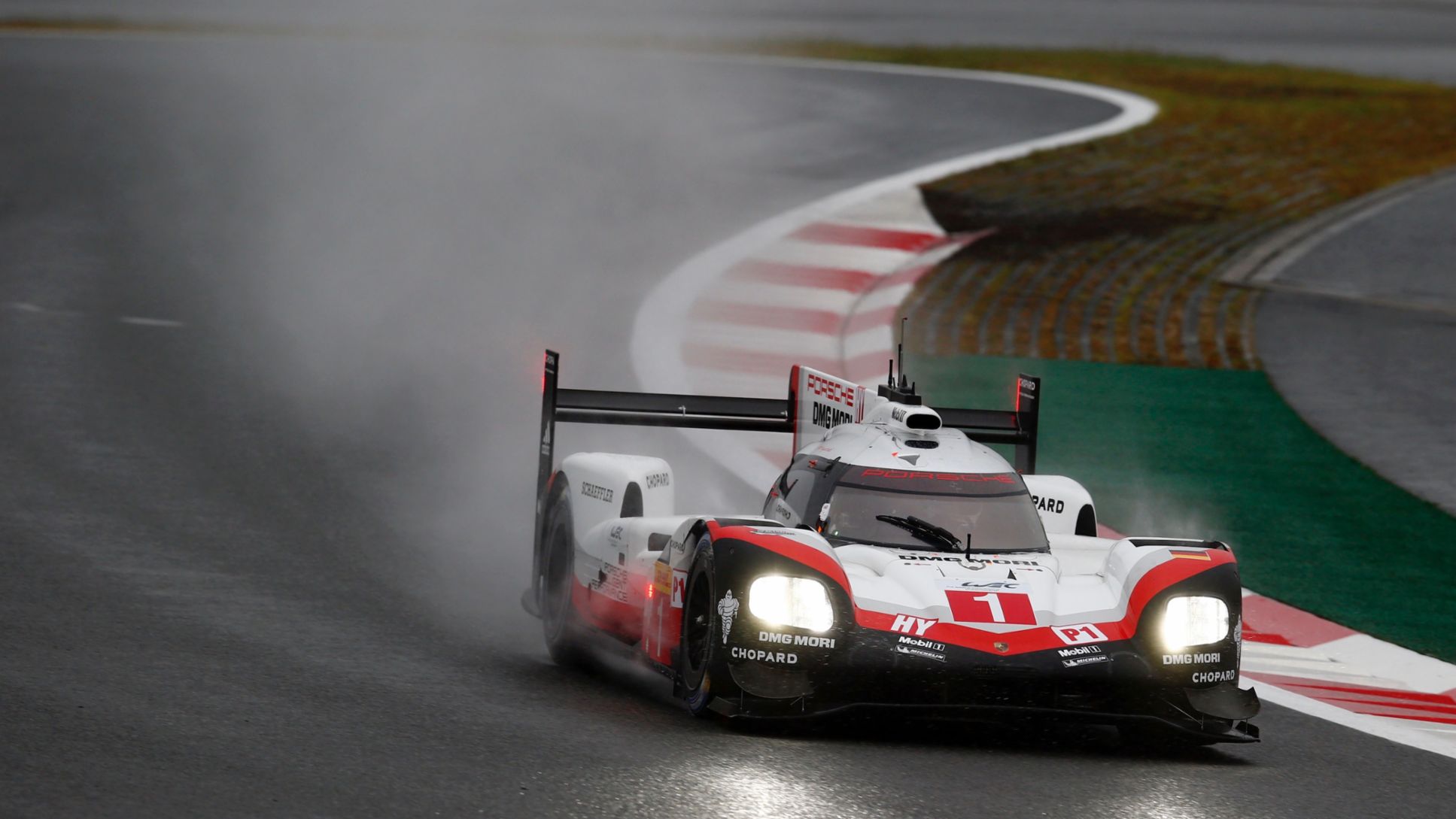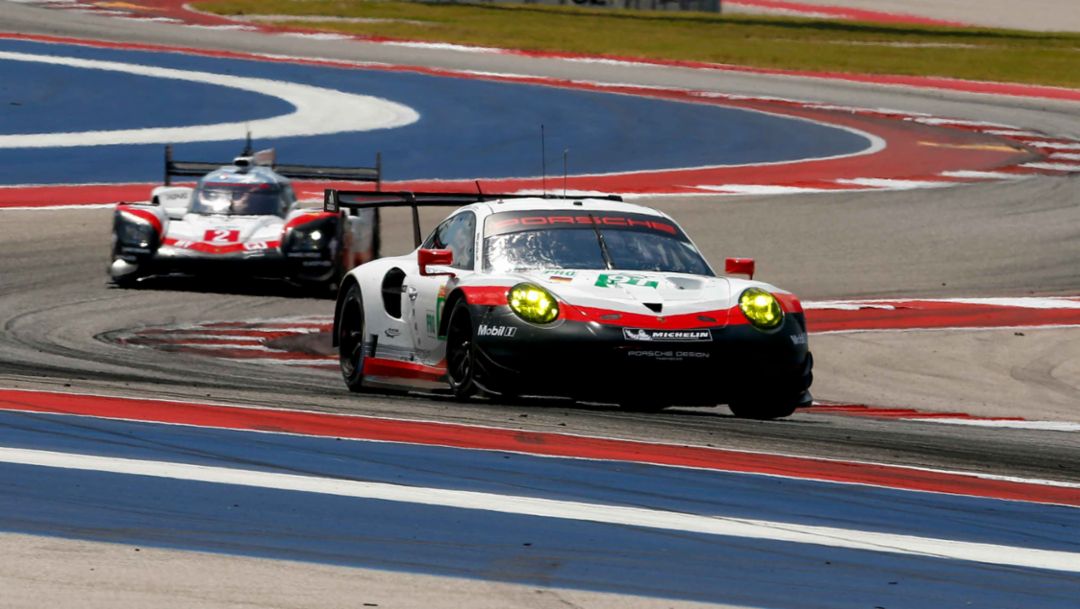LMP Team
The first two 90-minute practice sessions at the 4.56 kilometre long Fuji International Speedway took place in the rain in just 13 degree air and 17 degree track temperatures. The picturesque silhouette of Mount Fuji disappeared in fog while the spray on the very long 1.5-kilometre straight left the drivers with extremely poor visibility.
The trio of Neel Jani (CH), André Lotterer (DE) and Nick Tandy (GB) finished ahead of the sister car of the championship leaders Earl Bamber (NZ), Timo Bernhard (DE) and Brendon Hartley (NZ). The afternoon session was red flagged for a long time because of heavy rain. On the time sheets, Jani was second fastest, Bernhard was fourth. Their teammates didn’t even get the opportunity to drive. The overall best time of the day was achieved by Lotterer in the morning with a lap of 1:35.527 minutes.
The six-hour race is awaited with huge excitement but not only because of the difficult conditions: If the Le Mans winners Bamber/Bernhard/Hartley finish the race ahead of the best placed Toyota (car number 8), they would become the new drivers’ world champions. However, next on the programme is qualifying on Saturday from 15:00 to 15:20 hrs local time. The six-hour race on Sunday will start at 11:00 hrs local time.
The Porsche LMP Team after practice
Andreas Seidl, Team Principal: “This wasn’t an easy Friday. Due to the weather conditions we obviously could not tick off our usual job list. Nevertheless, both cars ran without any issues and we gathered some information on the wet track which might be useful given how the weather is predicted for the weekend. The most important thing actually on such a day is to have both cars back in the garage in one piece.”
Earl Bamber (27, New Zealand): “As soon as I got into the car this morning I had a good feeling. At the beginning, there was a lot of aquaplaning but then it reduced. When there are a lot of cars running, the water is moved off the track and it is not too bad. I think in damp conditions we are strong and in the afternoon Toyota looked formidable in heavy rain. So we have to improve on this. I think it is great to be back here. I like Japan and the Fuji Speedway a lot although I still try to find the mountain this year!”
All the drivers' quotes in the press release (see downloads).
GT Team
The Porsche GT Team fields two Porsche 911 RSR at round seven of the WEC on the Fuji Speedway. The 510 hp race car was designed from scratch by Porsche Motorsport in Weissach for the 2017 season and will tackle the GTE-Pro class on the storied racetrack at the foot of Mount Fuji against strong opposition from Aston Martin, Ferrari and Ford. The fight for the world championship in this category – in which Porsche currently ranks second in the drivers’ classification with Richard Lietz (Austria) and Frédéric Makowiecki (France), within striking distance of the title – is particularly fierce. In the GTE-Pro class, the Balance of Performance regulation aims to achieve a level playing field for the different vehicle concepts to ensure balanced and fair races, making this category particularly competitive. Equally as close is the title fight in the GTE-Am class. In this class, Porsche’s customer squads Dempsey Proton Racing and Gulf Racing successfully field two 911 RSR from the 2015 model year.
The Porsche drivers
The Porsche GT Team aims to defend its title chances at Fuji with four works drivers. Richard Lietz (Austria) and Frédéric Makowiecki (France) share the cockpit of the #91 Porsche 911 RSR. Their team colleagues Michael Christensen (Denmark) and Kévin Estre (France), who scored their top result so far this season recently in Austin with second place, drive the second new 911 RSR with the starting number 92. In the GTE-Am class, two Porsche customer squads field 2015-spec 911 RSR racers: Dempsey Proton Racing campaigns the #77 car with the Porsche Young Professional Matteo Cairoli (Italy) as well as Christian Ried and Marvin Dienst from Germany. Achieving victories at the Nürburgring and in Mexico City, they currently rank second in the FIA Endurance Trophy. Ben Barker and Michael Wainwright from Great Britain join forces with Nick Foster from Australia to compete in 911 RSR fielded by Gulf Racing.
Comments before the race
Dr. Frank-Steffen Walliser, Vice President Motorsport and GT Cars: “After the strong team effort in Austin and second place after a sensational charge through the field, we’re heading to Fuji full of confidence. In Japan, we aim to build on this strong performance and bring home another top result from our new 911 RSR’s first outing in Asia. This would put us in an even better position in the gripping fight for the world championship in the lead-up to the final two rounds in Shanghai and Bahrain.”
Marco Ujhasi, Director GT Factory Motorsports: “The important thing in Fuji is to carry plenty of speed onto the long straight after the start and get the tyres up to the perfect working temperature before the first corner so that the brakes and tyres perform optimally. This scenic racetrack is good for surprises, particularly when it comes to the weather. We have to be ready for anything.”
Drivers' quotes in the press release (see downloads).
Cars
The Porsche 919 Hybrid
The class 1 Le Mans Prototype (LMP1) develops a system power of around 900 HP (662 kW) that comes from a compact two-litre turbo charged V4-cylinder (nearly 500 HP/368 kW) engine and two different energy recovery systems – brake energy from the front axle combined with exhaust energy. The combustion engine drives the rear axle while the electro motor boosts the front axle with an output of more than 400 HP (294 kW). The electrical energy that comes from the front brakes and the exhaust system is temporarily stored in a liquid-cooled lithium ion battery.
The Porsche 911 RSR
Porsche Motorsport built the 911 RSR a completely new development on the basis of the high-performance 911 GT3 RS sports car: the suspension, body structure, aerodynamic concept, engine and transmission have all been designed in Weissach from scratch for this season. Depending on the size of the restrictor, the motor, which is now positioned in front of the rear axle, puts out around 375 kW (510 hp). Thanks to the particularly large rear diffuser combined with a top-mounted rear wing, the level of downforce and the aerodynamic efficiency were significantly improved. The new RSR scored its maiden victory at the American IMSA SportsCar Championship race at Lime Rock on 22 July.
Balance of Performance (BoP)
The Balance of Performance applies to the GTE-Pro class of the WEC Sports Car World Endurance Championship as well as the GTLM class of the IMSA SportsCar Championship. BoP was introduced by the FIA with the aim of achieving a level playing field for the different vehicle concepts, and thus ensuring balanced and fair races. The intention is that it should not make a fundamental difference if a vehicle is powered by a turbocharged or normally aspirated engine, or if the engine is mounted on the front axle or in front of the rear axle. The basic aerodynamic shape of the vehicles should also not play a decisive role. After an initial grading by the FIA, the balance of performance is adjusted at the races by means of telemetry - not only using lap times, but also acceleration profiles and engine mappings. This data input is automatically analysed and incorporated into the Balance of Performance. The most frequently used means of adjusting the performance level is through adding or subtracting weight. In keeping with the rule-makers’ intention, the key to success on the racetrack is not about the individual potential of a vehicle, instead it’s about the performance of the drivers, the race strategy, a perfect setup or the skill of the team with their pit stops.
The race
Sports car racing has enjoyed a long tradition on the Fuji Speedway. Fans in the Land of the Rising Sun are knowledgeable and enthusiastic. This challenging racetrack, which hosted Formula 1 for many years, features 16 corners and lies in the picturesque town of Oyama, with Mount Fuji as the backdrop. In the 1980s, Porsche celebrated major successes with its sports cars at the legendary 1,000-kilometre races held here.
Schedule
Local time:
Friday, October 13 2017
11:00-12:30 hrs 1st free practice
15:30-17:00 hrs 2nd free practice
Saturday, October 14 2017
10:30-11:30 hrs 3rd free practice
15:00-15:20 hrs Qualifying LMP1 & LMP2
Sunday, October 15 2017
11:00-17:00 hrs Race
TV and live streaming
The official WEC App can be downloaded free of charge with an extended (not free of charge) version available which includes full live streaming and full timing. The live stream is voiced by the FIA WEC TV team including live interviews from the pits.
The WEC races can be followed on various international TV channels in Europe, Asia, Australia and New Zealand, North and South America as well as in the Middle East and Africa.
Facts and figures
The WEC efficiency regulations limit the amount of energy that can be used per lap. On the 4.56 kilometres long lap of the Fuji International Speedway, the Porsche 919 Hybrid can use 4.15 megajoule of electrical power from en-ergy recovery systems and 1.163 kg/1.606 litres of petrol.
At normal race speed, the 919 Hybrid is due for refuelling after 37 laps.
Refuelling and changing tyres may only be done sequentially, not at the same time. Only four mechanics may work simultaneously when changing tyres and also may use only one wheel gun at a time. That takes a lot longer than in F1, for example.
The drivers are normally only changed when new tyres are needed.
These different types of tyres can be used: three different compounds of slick tyres for dry conditions, a hybrid tyre (no profile either but softer cover) for mixed conditions and wet weather tyres. Four sets of dry weather tyres are available per car for qualifying and the race, this is two sets less than in 2016.
A lap on the Speedway has ten right handers and six left handers.
The circuit opened in 1966 and had a reputation of being dangerous until its modernisation in 2005. In 1976 and 1977 it was the venue of the Japanese Formula One Grand Prix. In 1976 Niki Lauda gave up in heavy rain, James Hunt becoming world champion. One year later saw a terrible accident. Only in 2007 and 2008 did Formula One return again racing at the new track.
From 1982 to 1988 the sportscar world championship held a round in Fuji. In 1983 Stefan Bellof, driving a Porsche 956, did the fastest ever lap there in 1:10.02 minutes on the old track that measured 4.360 kilometres.
Mount Fuji is an active volcano that last erupted in 1707. It is the highest mountain in Japan at 3,776 metres and is regarded as a holy mountain.
The circuit is located about 100 kilometres southwest of the capital of Tokyo on the Japanese main island of Honshu.
The World Endurance Championship
Sports prototypes and GT vehicles contest the Sports Car World Endurance Championship (WEC) in four classes: LMP1 (eg. Porsche 919 Hybrid), LMP2, LMGTE-Pro (eg. 911 RSR) and LMGTE-Am (eg. 911 RSR model year 2015). They all compete together in one race but are classified separately. At Le Mans, double points are awarded in all classes towards the championship.
Info
All scores: http://www.fiawec.com/en/season/result
All results: http://fiawec.alkamelsystems.com
Consumption data
911 GT3 RS: Fuel consumption combined 12.7 l/100 km; CO2 emissions 296 g/km

.jpg/jcr:content/-b_M17_5112_fine%20(1).jpg)
